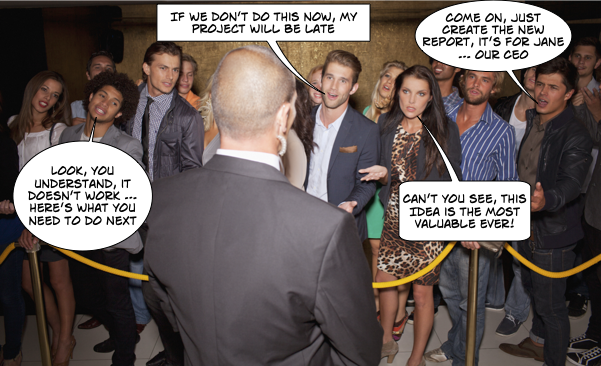Behaviors and Culture Can Impair Creating Good Product

When we think about culture, we often consider nationality, regional cultures, and today, we frequently hear about identity and demographic aspects of culture. For myself, culture comes up in dinner discussions with my wife and friends. It’s great to reflect on how our upbringing, surroundings, and possibly even our genetics influence our work habits, our collaboration with others, and our perception and interaction with authority. Culture is a challenging thing to work with because it’s deeply ingrained in us – it’s all around us.
For the last 15 years, Digital.ai (f.k.a., VersionOne) has released The Annual State of Agile Survey (read it here). Within the survey, it is obvious that aspects of culture are the leading challenges to all aspects of an agile way of working. In the latest version of the survey, there was one question that really highlighted the cultural challenges (note, I plucked out the key responses that impact culture – be sure to check out the full survey):
Agile Adoption Barriers
- Inconsistencies in processes and practices – 46%
- Cultural clashes – 43%
- General organization resistance – 42%
- Absence of leadership participation – 40%
- Inadequate management support and sponsorship – 40%
Prior to the survey’s release, I had already started making a list of the human behaviors and cultural behaviors that I’ve seen impact an organization’s ability to build good software products, as well as those behaviors that negatively impact an organization’s continuous improvement initiatives.
Common Cultural Barriers in Product Teams
Here’s my list of barriers:
- Fear of Losing Control. This is primarily an individual fear; however, it can also be ingrained in the organization. I’ve heard, “if I don’t put these controls on how the team works and if I’m not making decisions, when they screw up — I’m the one that is going to hang.” Of course, the idea of control being lost ultimately becomes a myth, because we generally see everyone’s engagement rise up a notch or two. Thus, resulting in more people being involved in making the decisions at the proper levels — hence scaling the organization.
- Gate Keeper Culture. Often a subset or product of Fear of Losing Control, this is the manager or director who acts the liaison between his or her direct reports and the rest of the organization. I’ve seen and even lived in environments where all communications have to go up and down the ladder. Or, where in order to talk to someone on the “protected” team, you have to walk past the Gatekeeper and they then take the message or grant permission as long as they are part of the discussion.
- Measurement of Success is Based upon “On Budget and On Time”. Many organizations, especially IT organizations live in the world where they try only be concerned with what they can control — and that is generally, “we deliver what was signed off and will do it based on a budget and set schedule.” Well, we fail to recognize that we should be measured based on the success of the product either in the marketplace or the usage internally. The funny part is when we time box and quit focusing on the when and who, and instead focus on the what — everyone is happier, including the development teams.
- “What’s My Role?” Fear. This is the protectionist behavior where managers and or team members don’t see a fit for themselves or don’t find a fit for themselves as an agile transformation takes place. These team members or managers generally start creating barriers to deflect blame while at the same time climbing to the rooftops to shout out about the failures of the team and process. If others are looking at the right thing (e.g., product moving out successfully
- Victim Mentality. Have you ever heard, “it’s always been that way and it’ll never change”? Well, this is the typical response for the person who either doesn’t want to deal with change — or they’ve been told “NO” so much, they just give up. Personally, I used to be one of these people, then I learned quickly — if you don’t ask, you don’t get. And, if it is something that could have really positive results — isn’t it worth the risk?
- Super Hero Culture. Now, don’t get me wrong, I appreciate hard work and stepping up your game to make sure we succeed as a team. However, constantly overcommitting and being allowed to do so repeatedly is not a good thing. I’ve also seen that individual who loves to be on a pedestal, thus when we start working more as a team — they’ll often be the person making back room deals to do more work or take on the clandestine project that our Scrum Master isn’t supposed to know about. Again, hard work is great — but we have to respect the concepts of sustainable pace, transparency, and “The Team”. Remember, we regularly deliver value.
- Us/Them Culture. This one is obvious, but it takes on several forms, including department silos, role-based silos, and Ivory Tower silos. Department silos exist when we have complex solutions that require the integration of products from multiple departments, and there is a lack of rapport or poor communication between the teams. Role-based silos will generally exist in early agile adoptions where the value of diversification and cross-functional teams has not yet been visible. And Ivory Tower silos are those where “I’m a Director” or “I’m the Product Manager” is the mindset, and you do what I say. This never results in teamwork, unless the team is conspiring together to take down the Tower (watch Miracle if you want to see an example). If people refer to managers in the organization as “The Suits”, then you might have some Ivory Tower silos and possibly be heading in the opposite direction.
What are your challenges?
What challenges, either cultural or behavioral, have you experienced? I’m interested in hearing about the cultural factors that not only impacted your agile way of working but also those that influenced the delivery of great products.
Contact me at LinkedIn or Let’s Talk.



Responses